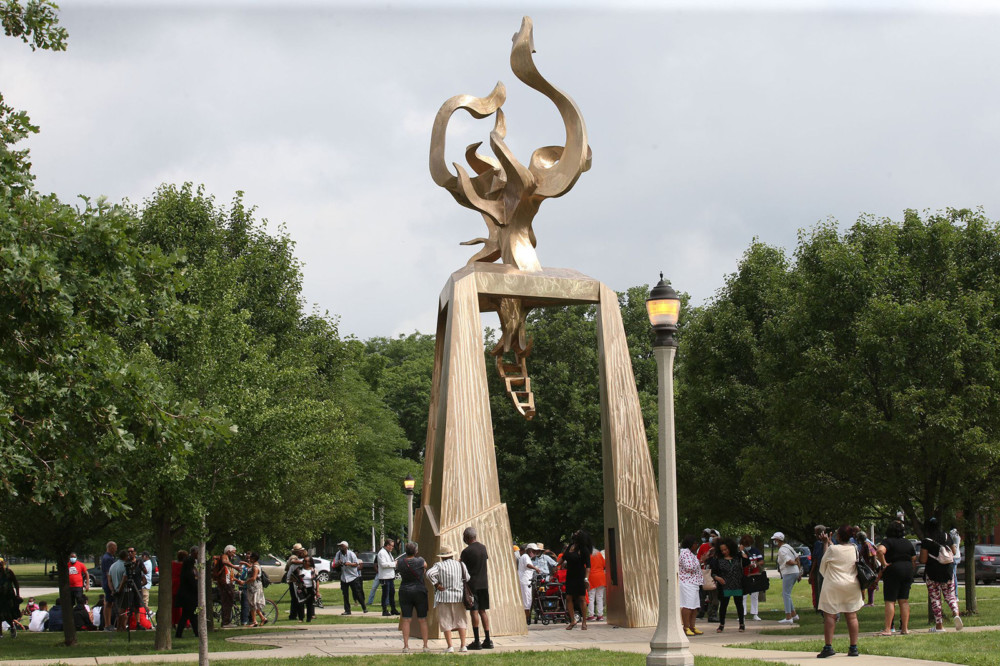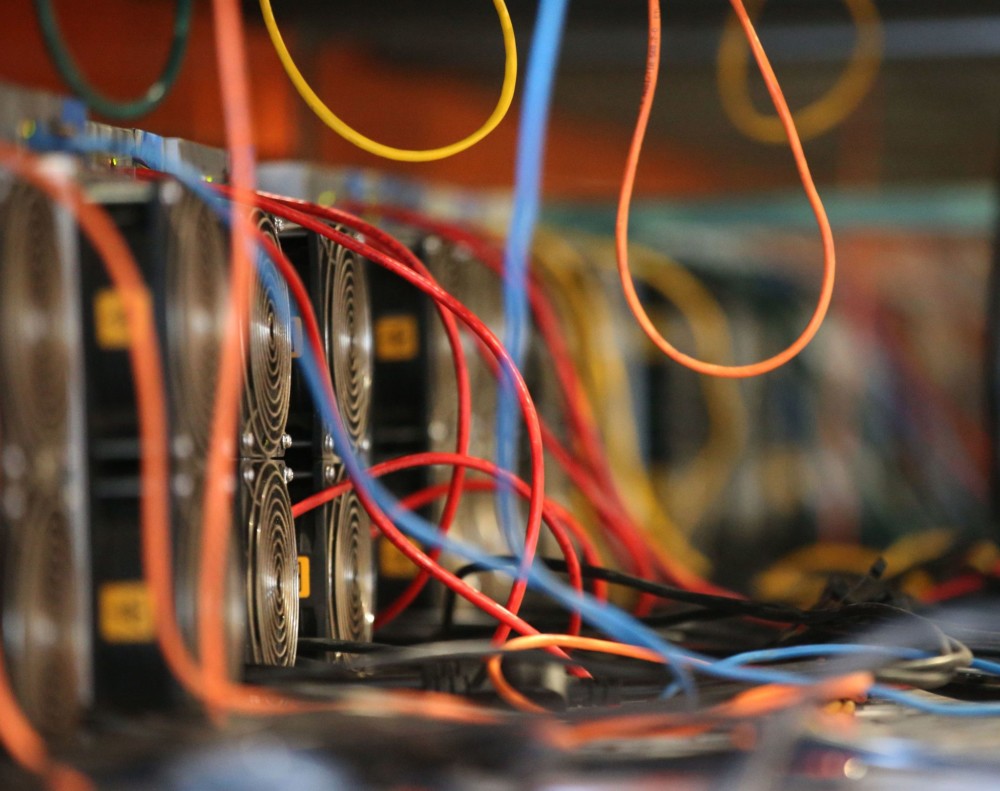Christopher Borrelli
Chicago Tribune
WWR Article Summary (tl;dr) The new 30-foot bronze statue celebrates the extraordinary life of Chicago investigative journalist Ida B. Wells.
Chicago
The Light of Truth Ida B. Wells National Monument in Chicago’s Bronzeville neighborhood, curling skyward above the modest trees of its surrounding park, stands 30 feet tall. Created by famed sculptor Richard Hunt, its tripod of bronze columns support, high over its base, a halo of abstraction, a tangle of bronze sheets twisted into coils, spirals, each jutting, grabbing.
“To be honest,” Roberta Trotter said, “I’m trying to figure out what we have here.”
On Wednesday morning, an hour before the city’s formal unveiling ceremony of the sculpture, which has been in the works for more than 13 years, Trotter squinted upward. She stepped back then squinted some more. She lives nearby. She wore purple pants, purple shoes, a purple blouse and purple eyeglass frames. On her lapel, she had pinned a small portrait of Wells, the early 20th century Chicago investigative journalist, suffragette, civil rights activist, NAACP co-founder and more. Trotter crossed her arms, walked beneath the work’s generous arches, stepped back, looked from another angle.
“It’s not that I’m not a fan,” she said.
She turned her head with the turn of the sculpture. “It’s that I’m curious. On top, is that a hat? A crown of thorns? It is interesting. I just want to know what the artist thinks before I say more. But I do see a strong base. That, I understand — Ida was a strong woman.”
As the morning went on, a crowd gathered, waiting for the mayor and Hunt and others, driven into a nearby community center by the threat of rain, to walk over and offer more. Neighbors stopped by on the way to work. Children gathered with their summer camp leaders. Activists strolled in from corners of the city. Every head tilted back, wondering.
“I don’t know what it is but it’s beautiful,” said John L. Bash, who lives across the street.
“Is that fire on top?” asked Timothy Phillips, who lives nearby. “No, wait — ribbons?”
Mildred Boston clapped her hands and beamed ahead. “Oh, that’s Ida and that’s her climbing a ladder to Heaven, there’s the throne there and also the outstretched arms.”
Indeed, it might be easier to say what we know for sure about the Light of Truth. We know that its title is taken from Wells herself, who said: “The way to right wrongs is to turn the light of truth upon them.” We know Michelle Duster, Wells’ great-granddaughter, the face and leader of the long-running campaign to get the sculpture built, fundraised her way to its $300,000 price tag. We know it sits on the site of the Ida B. Wells Homes, which, for decades — until the housing project was torn down in 2011, and Congress Parkway renamed for Wells in 2018 — was the only serious memorialization of Wells.
We know The Light of Truth is one of the first monuments for a Black woman in Chicago.
And we know, as it was built over the past several weeks, neighbors embraced it quickly. Some already dubbed it “the Sears Tower of Bronzeville.” Prom photos were taken in front of it. “Hopefully it becomes a draw,” said Duster, the afternoon before the unveiling. “Hopefully it becomes a point of pride to Bronzeville, the kind of thing people want to serve as a backdrop to their lives here. That’s what I want — a gathering spot.”
Mission already accomplished.
As the crowd grew Wednesday, cars parked nearby and out came aging former residents of the Wells Homes wearing T-shirts of past reunions. Then more cars pulled up in front of those cars, strollers unfolded. The slow walk to the monument continued.
“We are the original Ida B. Wells,” said Debra Cannon.
“We are the Ida B. Wells,” said Michele Macklin.
Once across the street, what were they meant to see?
For the record, Hunt, speaking a day earlier in a phone interview, recalled his upbringing in Englewood and how his parents spoke of Wells as “a model of an African American woman who made headway.” At 85 now, his work is somewhat ubiquitous around the Chicago area, the distinctive metal flames of his public sculptures on college campuses, city streets, corporate headquarters, libraries. Light of Truth is of a piece with those. It is, to some extent, about “ascendence,” he said, but like Wells herself, it wants to contain multitudes. Duster said traditional busts and statues were considered but eventually they preferred “something interpretative, which gets across Ida better than the literal.”
So, again, 90 years after her death, Wells is leading a conversation. Mayor Lori Lightfoot, Duster and others spoke at the dedication at Oakwood Center on Vincennes Avenue. But the real talk was in front of the work itself, which is large enough to walk through — to stand in the middle of and think.
Sharron Troupe, assistant managing director of a nearby bank branch of CIBC, stood before the sculpture for a long while. “I see a combination of angels and doves, with Ida in the middle.”
Paul Carter listened.
“And I see a flame,” he said, “the fire that motived the early civil rights movement.”
“I take it you’re born and raised in Chicago?” Troupe asked.
“Just over there,” he said. “I see her vigor in this.”
“In my vision, angels,” she said.
“Eye of the beholder. Either way, hopefully, we get development in lots around here. This area used to be smoking with people on a Saturday. It was an affluent community.”
“A Black-owned community.”
“That’s right.”
Does any statue in your neighborhood solicit this much discussion? Has it ever? Reclining in the grass, waiting for the ceremony to start, Myles Francis of South Shore, a project manager at the Chicago Center for Youth Violence Prevention (who is also working with a group to get a monument created that marks the victims of the 1919 race riot), said he hopes this goes a way “toward Chicago recognizing more of a Black history. There’s the renaming of Lake Shore for DuSable, but this, I appreciate this — this takes up space.”
He saw a torch, or no, maybe stairs and a torch.
Okema Lewis, wearing a shirt with Wells’ face plastered across the back, clutching a paperback copy of Wells’ autobiography, was clear: “No, that’s a set of stairs to reflect the travels of Ida B. Wells, and those? Those are the horns that jabbed at her on the way.” She heard people say they were disappointed, that they wanted a clear likeness of Wells. But this, the stairs, the horns, it speaks to her. She earned her masters at 65, from the Bronzeville branch of Northeastern Illinois University, a couple of blocks away.
She sees the sculpture here, now, an act of kismet.
“Ida fought discrimination, fought for equity. I studied urban communities — over there. When the bus would drop me off for class, people assumed I was going home to a project. People don’t even know that school exists. To have this monument steps away, it means something, right? I hope the students come and sit here. I hope we all do.”
Distributed by Tribune Content Agency, LLC.
















































































































































































































































































































































































